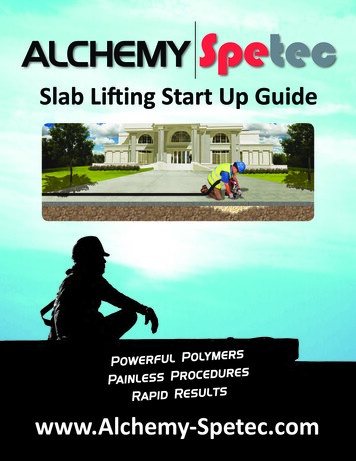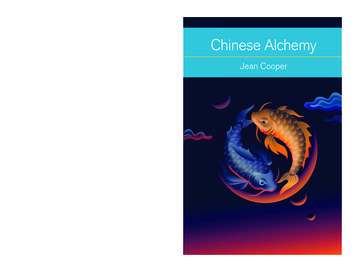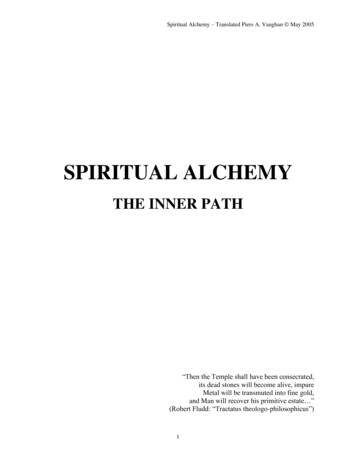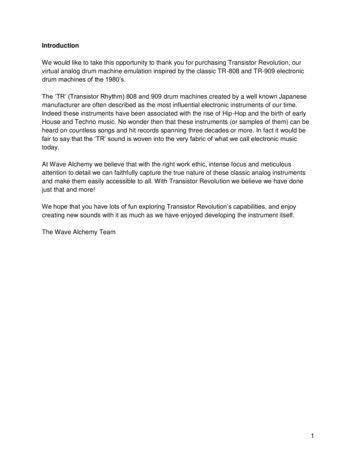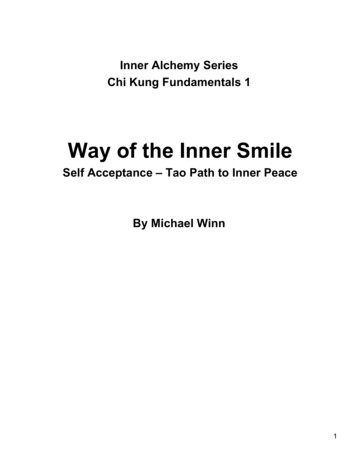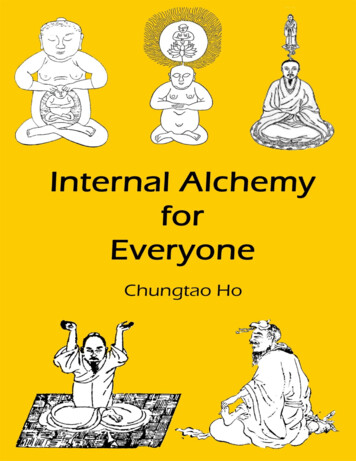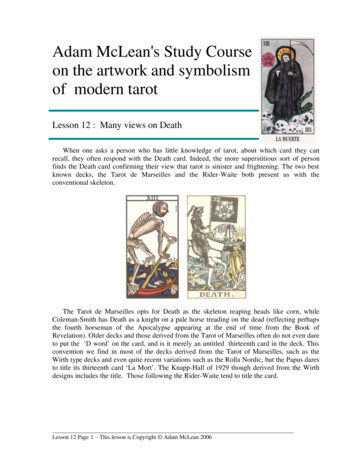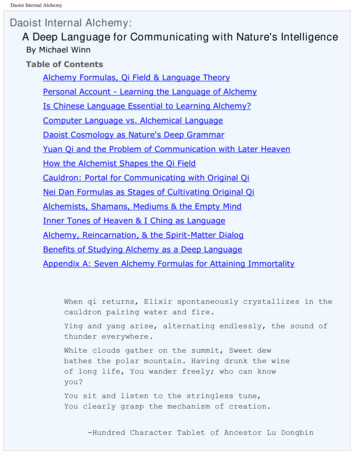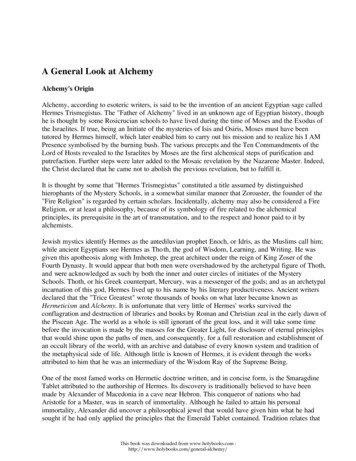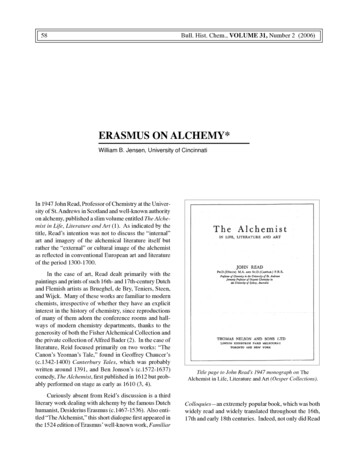
Transcription
Bull. Hist. Chem., VOLUME 31, Number 2 (2006)58ERASMUS ON ALCHEMY*William B. Jensen, University of CincinnatiIn 1947 John Read, Professor of Chemistry at the University of St. Andrews in Scotland and well-known authorityon alchemy, published a slim volume entitled The Alchemist in Life, Literature and Art (1). As indicated by thetitle, Read’s intention was not to discuss the “internal”art and imagery of the alchemical literature itself butrather the “external” or cultural image of the alchemistas reflected in conventional European art and literatureof the period 1300-1700.In the case of art, Read dealt primarily with thepaintings and prints of such 16th- and 17th-century Dutchand Flemish artists as Brueghel, de Bry, Teniers, Steen,and Wijck. Many of these works are familiar to modernchemists, irrespective of whether they have an explicitinterest in the history of chemistry, since reproductionsof many of them adorn the conference rooms and hallways of modern chemistry departments, thanks to thegenerosity of both the Fisher Alchemical Collection andthe private collection of Alfred Bader (2). In the case ofliterature, Reid focused primarily on two works: “TheCanon’s Yeoman’s Tale,” found in Geoffrey Chaucer’s(c.1342-1400) Canterbury Tales, which was probablywritten around 1391, and Ben Jonson’s (c.1572-1637)comedy, The Alchemist, first published in 1612 but probably performed on stage as early as 1610 (3, 4).Curiously absent from Reid’s discussion is a thirdliterary work dealing with alchemy by the famous Dutchhumanist, Desiderius Erasmus (c.1467-1536). Also entitled “The Alchemist,” this short dialogue first appeared inthe 1524 edition of Erasmus’ well-known work, FamiliarTitle page to John Read’s 1947 monograph on TheAlchemist in Life, Literature and Art (Oesper Collections).Colloquies—an extremely popular book, which was bothwidely read and widely translated throughout the 16th,17th and early 18th centuries. Indeed, not only did Read
Bull. Hist. Chem., VOLUME 31, Number 2 (2006)fail to note the existence of this work (5), there is also nomention of it in the standard English works on alchemyby Taylor (6) and Holmyard (7), in the index to Ambix(the primary scholarly journal dealing with the historyof alchemy), nor in the multivolume general histories ofscience and chemistry by Thorndike (8) and Partington(9). Only Hermann Kopp’s 1886 work, Die Alchemiein Älterer und Neurer Zeit, gives it a passing mentionin the form of a two-sentence summary (10). However,since the writing of the original draft of this introduction,it has come to my attention that Stanton Linden’s 1996literary study, Dark Hierogliphicks: Alchemy in EnglishLiterature from Chaucer to the Restoration, does providea detailed summary of the tale, though this work, whichwas largely intended for historians of English literature,is unfortunately unknown to most historians of chemistry (11). Despite this exception, the relative neglectof Ermasus’ tale is readily apparent from the statisticsfound in Alan Pritchard’s exhaustive bibliography ofsecondary works dealing with the history of alchemy,which contains 34 entries for Chaucer and 18 entries forJonson, but none for Erasmus (12).59Erasmus was also responsible for editing and/ortranslating works by such classical authors as Pliny,Seneca, and Lucian; for his comprehensive editionsof the writings of such early church fathers as Jerome,Augustine, Origen, Irenaeus, and Cyprian; and, mostimportantly, for publishing the first printed edition of theNew Testament in the original Greek. Indeed, the moderncomprehensive English translation of his collected works,currently being published by the University of TorontoPress, promises to exceed more than 88 volumes beforeit is completed (14).Desiderius ErasmusBorn in either Rotterdam or Gouda, Holland, sometimebetween 1460 and 1470, Erasmus was ordained as aCatholic priest in 1492 (13). However, he soon foundthe monastic life unbearable and instead contrived tomake a living through a combination of teaching, editing,and writing. His travels as an itinerant scholar wouldeventually take him to most of the countries of Europeand to England, where he would become a close friendof Sir Thomas More.Most readers are probably familiar with Erasmusthrough an encounter with one of the many modern editions of The Praise of Folly, his famous satire on humanweakness, vanity, and superstition, first published in1511 (Books in Print lists no fewer than ten editions currently available). However, this represents only a smallfraction of his scholarly output. He authored importanttextbooks on rhetoric and grammar and wrote extensively on humanistic education. In 1500 he published acollection of pithy proverbs and adages culled from thewritings of classical Greek and Roman authors. Knownas the Adagia, it rapidly became a European rage andessentially made Erasmus’ reputation. Before his death,it would pass through numerous editions, revisions, andenlargements, and would eventually contain more than4,150 entries.Desiderius Erasmus of Rotterdam (c. 1467-1536). Anengraving by Albrecht Dürer showing Erasmus in 1526,shortly after he composed his dialog on alchemy (OesperCollections).The ColloquiesFirst begun about 1498 in conjunction with his teaching activities, the Colloquies (from the Latin colloquor,meaning “to converse”) were originally composed byErasmus in order to provide students with entertainingexamples of both conversational and written Latin. Anunauthorized edition of the Colloquies was first publishedin Basel in 1518, followed by an authorized, corrected
60edition the next year. Between 1519 and 1533 Erasmuswould expand and revise the Colloquies no fewer than17 times, so that, by the time of his death in 1536, thebook would contain a total of 61 dialogues. The natureof the dialogues themselves also gradually evolved overtime, becoming increasingly satirical and pointed in theirportrayal of the mores and foibles of early 16th-centurysociety.As already noted, the dialogue entitled “The Alchemist” was first added by Erasmus to the Colloquies in1524. Set as the story of the duping of a wealthy dignitary named Balbinus by an anonymous priest posing asan alchemist, it is related in the form of a gossip-ladenconversation between two old friends named Philecousand Lalus. Though its general theme—the alchemist ascon man—is essentially identical to that of the Yeoman’sTale related 133 years earlier by Chaucer, the details ofthe two stories are quite different. Chaucer makes agreat show of his technical knowledge by reciting listsof laboratory reagents, apparatus, and procedures. In hisversion, the victim, rather than the alchemist, is a priestand is not only taken into the alchemist’s laboratory, butis also allowed to assist in the laboratory operations.Using a powder of his own making, the alchemist successfully transmutes both mercury and copper into silverfor his victim, each time introducing the silver by a ruseof some sort (e.g., silver filings secreted in a hollowedcoal, in a hollow stirring rod, etc.) while simultaneouslydistracting his dupe. In the end, the priest, convincedthat the alchemist’s powder works, purchases it for a sumof money and the alchemist departs.In Erasmus’ version, the technical details of the laboratory operations and the use of alchemical terminologyare minimal. Instead the emphasis is on the psychological details of how the alchemist manipulates his victim’sgreed and vanity and in detailing the many ploys whichhe uses in order to explain away his lack of success inthe laboratory and to extract ever greater sums of moneyfrom his dupe (e.g., gold is needed to seed or attract freshgold; the charcoal and other chemicals are impure or ofthe wrong variety; the glassware is defective; improperprayers are used; threats are made of imprisonment forthe illegal practice of alchemy, etc.). Indeed, thoughthe alchemist goes through the pretense of setting up alaboratory, it is doubtful whether he ever performs anyactual laboratory work. In this respect Erasmus’ tale iscloser in spirit to the more elaborated version that wouldbe given by Jonson 86 years later, than it is to that ofChaucer. Though there is a great display of alchemicalterminology in Jonson’s play, there is no real labora-Bull. Hist. Chem., VOLUME 31, Number 2 (2006)tory, as the alchemist and his assistant are temporarilyoperating out of the house of a wealthy homeowner, whohappens to be away in the country.The TranslationCompared to the works of both Chaucer and Jonson,Erasmus’ tale has the twin advantages of brevity andless antiquated English usage (depending, of course, onthe age of the English translation)—virtues which makeit a tempting, albeit less challenging, choice for use asa supplementary reading in an introductory history ofchemistry course. There are three English translations ofthe complete Colloquies to choose from—the first madeby Henry Munday in 1671 (15), the second by NathanBailey in 1725 (16), and the third by Craig Thompson in1965 (17) —as well as numerous translations of selectedColloquies. Since the dialogue is apparently relativelyunknown among chemical historians, we have chosen toappend a typical English rendition for the use of teachers and students based on the 1902 translation madeby Merrick Whitcomb of the University of CincinnatiDepartment of History, which is, in turn, based largelyon the 1725 translation of Bailey (18).REFERENCES AND NOTES* One of the original purposes of the Bulletin for theHistory of Chemistry was to publish not only scholarlyarticles related to the history of chemistry, but also occasionally to reprint primary documents and translationsthat might be of interest to its readers. Hence, the reasonfor publishing the following translation of the littleknown satire on alchemy by the 16th-century humanist,Desiderius Erasmus, for which Dr. Jensen has provideda brief introduction.1.2.J. Read, The Alchemist in Life, Literature and Art, Nelson,London, 1947. Read received the 1959 Dexter Award forhis contributions to the history of chemistry.It is obvious in reading Read’s book that he hoped thatthese external cultural images would also cast someobjective light on actual alchemical practice. As a consequence, he somewhat naively assumed that the art work,in particular, provided the viewer with actual first personrepresentations of real alchemists and actual alchemicallaboratories. In fact, as Hill has emphasized, many ofthese paintings are really imaginary artistic interpretationsrather than objective “photographic” representations. Theprofusion of chemical apparatus—probably modeled onthat of the local apothecary—found scattered about thefloor in most of these paintings was designed to displaythe artist’s virtuosity in the painting of complex still lives
Bull. Hist. Chem., VOLUME 31, Number 2 (2006)rather than to accurately portray the state of chaos foundin a typical working laboratory. For further details, seeC. R. Hill. “The Iconography of the Laboratory,” Ambix,1975, 22, 102-110.3. For a typical modern edition, see G. Chaucer, The General Prologue to the Canterbury Tales and the Canon’sYeoman’s Prologue and Tale, Holmes and Meier, NewYork, 1976. For a modernized version, see F. E. Hill,The Canterbury Tales Translated into Modern EnglishVerse, McKay, New York, 1965.4. For a typical modern edition, see B. Jonson, The Alchemist, Yale University Press, New Haven, CT, 1974.5. Nor is the dialogue mentioned in Reid’s other works. SeeJ. Read, Prelude to Chemistry: An Outline of Alchemy,Its Literature and Relationships, Bell, London, 1936, andJ. Reid, Through Alchemy to Chemistry: A Procession ofIdeas and Personalities, Bell, London, 1957.6. F. S. Taylor, The Alchemists: Founders of Modern Chemistry, Schuman, New York, 1949.7. E. J. Holmyard, Alchemy, Penguin, London, 1957.8. L. Thorndike, A History of Magic and ExperimentalScience, Macmillan, New York, 8 volumes, 1923-1958.There are ten index entries for Erasmus in Vol. V and VI,which deal with the 16th century, none of which refers tohis dialogue on alchemy.9. J. Partington, A History of Chemistry, Macmillan, London,4 volumes, 1961-1970.10. H. Kopp, Die Alchemie in Älterer und Neurer Zeit: EinBeitrag zur Culturgeschichte, Winter, Heidelberg, 1888,Part I, p 228. By way of contrast, no mention of Erasmusis found in E. O. Lippmann, Enstehung und Ausbreitungder Alchemie, Springer, Berlin, 1919.11. S. J. Linden, Darke Hierogliphicks: Alchemy in EnglishLiterature from Chaucer to the Restoration, Universityof Kentucky, Lexington, KY, 1996, Chapter 3.6112. A. Pritchard, Alchemy: A Bibliography of English-Language Writings, Routledge and Kegan Paul, London,1980. This also includes all articles appearing in Ambixprior to 1980.13. A concise summary of the life and work of Erasmus canbe found in J. McConica, Erasmus, Oxford UniversityPress, Oxford, 1991. More detailed studies are listed inthe bibliography of this volume.14. The Collected Works of Erasmus, University of TorontoPress, Toronto, 88 volumes, 1974-present.15. H. M. Gent. (H. Munday), The Colloquies or FamiliarDiscourses of Desiderius Erasmus of Rotterdam, Rendered into English, Brome et al., London, 1671.16. N. Bailey, All the Familiar Colloquies of DesideriusErasmus of Rotterdam Concerning Men, Manners, andThings, Translated into English, Darby et al., London,1725.17. C. R. Thompson, The Colloquies of Erasmus, Universityof Chicago, Chicago, IL, 1965. Reprinted as Vol. 39 and40 of Ref. 14.18. M. Whitcomb, Select Colloquies of Erasmus, Universityof Pennsylvania: Philadelphia, PA, 1902, 116-135.ABOUT THE AUTHORWilliam B. Jensen is Oesper Professor of the History ofChemistry at the University of Cincinnati, Cincinnati, OH45221-0172, and Curator of both the Oesper ApparatusMuseum and the Oesper Collection of Prints and Booksin the History of Chemistry. Dr. Jensen, founding editor of the Bulletin for the History of Chemistry, was therecipient of the 2005 Edelstein Award of the Histo
Alchemist in Life, Literature and Art (Oesper Collections). Bull. Hist. Chem., VOLUME 31, Number 2 (2006) 59 fail to note the existence of this work (5), there is also no mention of it in the standard English works on alchemy by Taylor (6) and Holmyard (7), in the index to Ambix (the primary scholarly journal dealing with the history of alchemy), nor in the multivolume general histories of .

